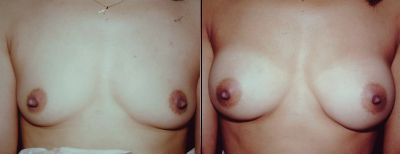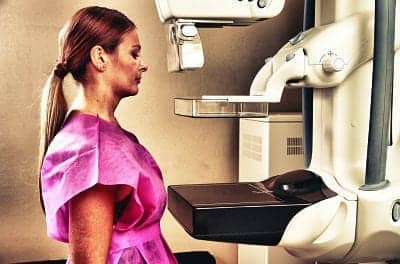
Nulliparous patient in her mid-20s with breast asymmetry; preop and postop augmentation with round smooth saline implants.
As a practicing plastic surgeon for the past 30 years—and as a former president of American Society of Plastic Surgeons—Walter L. Erhardt, Jr, MD, FACS, has seen the pendulum swing from silicone to saline and back to silicone breast implants, and he remains cautiously optimistic about the regulatory status of form-stable “gummy bear” breast implants.
Erhardt is a board-certified plastic surgeon who is nationally recognized for his expertise in plastic and reconstructive surgery. He earned his Bachelor of Science degree with honors, cum laude, from Roanoke College in Salem, Va, and received his medical degree from the University of Virginia School of Medicine. He completed his residencies in general surgery and in plastic and reconstructive surgery at Vanderbilt University Hospital. In addition, he is past director of the American Board of Plastic Surgery and former chair of the Written Examination Committee of the American Board of Plastic Surgery.
Erhardt is also in private practice in Albany, Ga, where he performs both cosmetic and reconstructive breast surgery, as well as facial rejuvenation and facial reconstruction following skin cancer treatment. In addition, he serves as chief medical adviser for breastimplants4you.com and as a medical adviser for The Consumer Guide to Plastic Surgery.

Nulliparous patient in her late-20s; preop and postop augmentation with round smooth silicone gel implants.
PSP: Breast augmentation efforts date back to the 1890s. Why has this attribute been so desirable for so long?
Walter L. Erhardt, Jr, MD, FACS: The breasts are a most outwardly noticeable part of the female body, and are associated with femininity and fertility. They are also nurturing and life-giving. Full, rounded breasts have long been considered desirable—just look at the Renaissance painters. The fitness boom in the 1970s and 1980s placed an emphasis on physique in general and the breasts in particular.
PSP: What were some of the biggest breast augmentation disasters?
Erhardt: Some of the earliest efforts at breast augmentation certainly created some major problems, ranging from the placement of sponges, to paraffin injections to the injection of free silicone into the breasts. The sponges and paraffin usually resulted in infection and hardening of the breast from scar tissue. The latter was disastrous because the silicone frequently didn’t stay where it was put. The gel would migrate and cause lumps in the breast or elsewhere, and often caused infection in and around the breasts.
An attempt to transplant a lipoma was one of the earliest efforts to try and augment a breast with a patient’s own fat, but that wasn’t very successful.

Patient in her 20s preop and postop with silicone gel implants.
PSP: Was there a light bulb or “a-ha” moment in the development of the modern-day breast implant?
Erhardt: Yes. Back in the Sixties, intravenous (IV) fluids and blood were stored in glass bottles. Blood was just starting to be stored in plastic bags, and some doctors began to notice how soft these bags felt. It was sort of, “Gee, this feels soft. If you could make a breast implant using a plastic shell like that, wouldn’t that be better than what we have?” And that is how the concept of an inert outer plastic shell filled with something soft came about in the early 1960s.
The creation of an inert outer shell filled with some substance that approximates the density and the feel of the breast is the greatest advance in breast augmentation. While significant major advances have occurred and continue to occur in the development of breast implants since then, we haven’t gone beyond the concept originally developed by Drs Thomas Cronin and Frank Gerow 50 years ago.

Patient in her 20s preop and postop with saline implants.
PSP: Fat grafting to the breast also has a history. The pendulum seems to be swinging back as we are again hearing about injecting fat into the breast.
Erhardt: This is still a work in progress. Frankly, for breast augmentation currently, this is a long run for a short slide. Fat injections to the breast can be useful for touching up breasts after reconstruction and to help camouflage some of the problems of an implant, like wrinkling and dimpling. There may be a niche for this surgery, but I don’t see it having a major role in cosmetic breast augmentation until we can deliver greater volumes with more consistent results than is typical today.
Right now, fat grafting for breast augmentation takes up to four times as long as it does to do the operation with an implant, is significantly more expensive, and the result can be often unpredictable. On top of that, the degree of augmentation possible is modest at best.
PSP: We have saline and silicone. Anything else ever used as a breast implant fill?
Erhardt: There have been a whole lot of other fillers that have been considered, but none have ever been approved by the FDA. We have looked at soybean oil and peanut oil, which are both radiographically neutral but have other health risks associated with them. Peanuts can be highly allergic. Soy is a phytoestrogen, and it has been suggested that it could stimulate the development of estrogen-dependent breast cancer.
PSP: Is any breast implant or augmentation method considered mammographically neutral today?
Erhardt: We haven’t gotten there yet. It would be nice if we could get one that was translucent with regard to mammography. Current implants do impact mammography.
PSP: What about these highly cohesive form-stable silicone gel, or “gummy bear” breast implants? Will they ever get the FDA’s nod?
Erhardt: The first patients in the US clinical trials will reach 10 years in 2011, so I think that we’re all hopeful that we may be getting close. While the form-stable silicone implant is not yet approved in the United States, it was originally introduced in Europe in 1993 and has been approved everywhere but the US. This is the “next generation” silicone implant; and US women deserve the same options as women worldwide. The collective data seems most favorable to date, and I am optimistic.
PSP: When the FDA banned the use of silicone breast implants in 1992, many women and surgeons turned to saline implants. Now that silicone implants are back, are they more or less popular than their saline counterparts?
Erhardt: With the exception of the US, the silicone gel-filled implant has been the preeminent implant everywhere in the world for quite a long time. Well over 90% of the implants utilized outside the United States are silicone.
And you’re right. Since 1992, the saline-filled implant was the predominant implant used here in the States. However, since its reintroduction back in the United States in 2006, the silicone gel-filled implant each year has become a more popular choice for women undergoing breast augmentation. And based on the data from the end of 2010, silicone implants this year have surpassed saline-filled implants in popularity here in the US.
PSP: How would you define the perfect breast implant? What qualities would it have?
Erhardt: Increased safety, radiographic neutrality, longer lasting, ease of detection of rupture all come to mind as desirable characteristics that I’m sure we would all like to see in manufactured devices.
Frankly, a procedure that could utilize a patient’s own tissues in a safe, efficient, and cost-effective way would also be great, which is why I believe we’re seeing a resurgence in the enthusiasm for fat grafting. We clearly have a significantly long way to go before this approach becomes a reality.
Stay tuned, because when you combine patient demand with a lot of very clever, highly educated minds, remarkable things can result.
Denise Mann is a freelance health writer in New York. Her articles regularly appear in WebMD, health.com, cnn.com, Arthritis Today magazine, American Profile magazine, and special sections of The Wall Street Journal. She is also the editorial director for several plastic surgery portals, including The Consumer Guide to Plastic Surgery.




